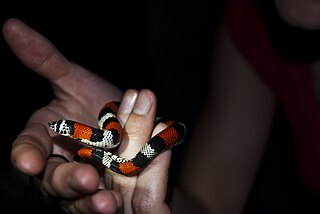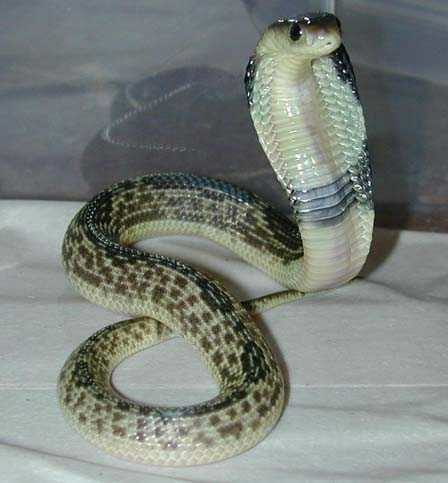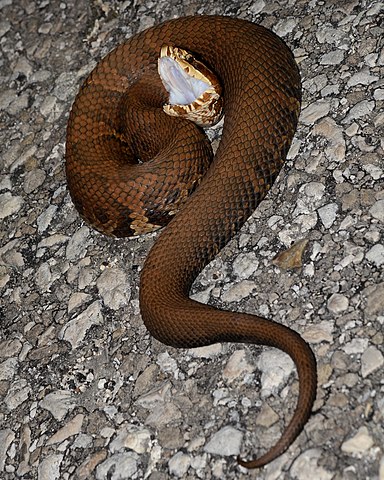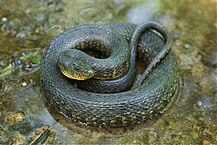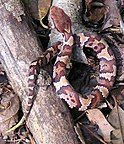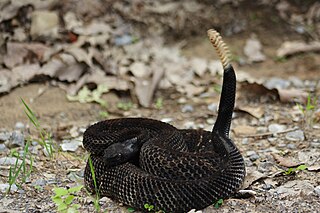The term “rear fanged” is applied to a variety of unrelated snakes that possess a venom-producing gland and 1-3 enlarged, grooved maxillary teeth in the rear of the mouth. We do not yet know how many species possess these venom-conducting teeth (“rear fangs”), but evidence indicates that snake venom evolved some 60 million years ago – before non-venomous snakes came into being. Therefore, all present day species may have evolved from venomous ancestors, and may possess at least the traces of venom glands. The rear-fanged snakebites I’ve dealt with in the course of my career have elicited only mild reactions. Some rear-fanged species, however, have caused fatalities – two very “famous” fatalities, in fact (please see below).
Snakes Best Kept in Zoos
As individual sensitivities and other factors can greatly affect one’s reaction to a bite, even “mildly venomous” species must be considered as potentially dangerous. A lifetime of experience as a zookeeper and herpetologist has taught me that it is impossible for a private snake owner to adequately prepare for or treat a venomous snakebite at home, or, prior to a bite, to arrange for treatment in a hospital.
Until we learn more about them, rear fanged snakes are best considered as suitable for display in zoos rather than private collections. Tentacled Snakes (Erpeton tentaculatum) and certain others may be an exception, but I advise consulting a herpetologist and an experienced medical doctor if you feel compelled to acquire a rear-fanged snake of any species.
Overview
Rear fanged snakes are classified in the huge family Colubridae (the “Typical Snakes”), but are not necessarily closely-related to one another. The term is applied to a variety of species that possess the venom-producing Duvernoy’s Gland. One, two, or three of the maxillary teeth in the rear of the mouth are enlarged and bear grooves on their front surfaces. Venom released by the Duvernoy’s Gland flows down these grooves and into a prey animal or foe. A period of “chewing”, in the manner of cobras and other Elapids, may be necessary in order to fully discharge the venom.
This method of introducing toxins into a wound is rather ineffective when compared to that employed by rattlesnakes and other Viperids. Also, many rear fanged species produce venom that is most or only effective against the specific animals upon which they feed. Therefore, not all present a threat to people.
However, much remains to be learned. For example, Boomslangs (Dispholidus typus) and Twig Snakes (Thelotornis kirtlandi) were not widely believed to be dangerous until each killed a prominent herpetologist! (I use “widely” because both were feared by local people).
Size
At an adult size of 8 inches, North and South America’s Crowned Snakes, (Tantilla spp.), are the smallest rear fanged species known.
Widely-distributed through much of Southeast Asia, the 7-foot-long Mangrove Snake (Boiga dendrophila), is the largest. This spectacular snake’s size and striking coloration render it much desired in the trade, and many are held in private collections. Those I’ve kept in zoos have remained high-strung and difficult to work with. Fatalities have not, as far as I know, been attributed to their bites, but large individuals can store up a substantial quantity of venom – I’d leave these beauties alone!
Diet
Many rear fanged snakes have evolved toxins that specifically target reptiles and amphibians, and may specialize in hunting lizards (Mexican Vine Snake, Oxybelis aenus), frogs and toads (Malagasy Giant Hog-Nosed Snake, Lioheterodon madagascariensis) or fish (Tentacled Snake, Erpeton tentaculatum).
Others, such as the Mangrove Snake (Boiga dendrophila), are generalists that consume a variety of creatures, including birds and mammals. The tiny Crowned Snakes, Tantilla spp., limit their diet to earthworms, centipedes, beetle grubs, and other invertebrates.
“Harmless Snakes” with Venom
Recent research has shown that 2,000 or more snake species, many considered “harmless”, likely produce true venom. Most do not have efficient rear fangs, and produce toxins that pose no danger to people, but this does point out the need for caution and research.
Further Reading
Venomous Snakebites: My Experiences and a New Study
The USA’s Most Dangerous Snake?
 That Reptile Blog – Reptile, Amphibian and Exotic Pet Care and Information
That Reptile Blog – Reptile, Amphibian and Exotic Pet Care and Information

